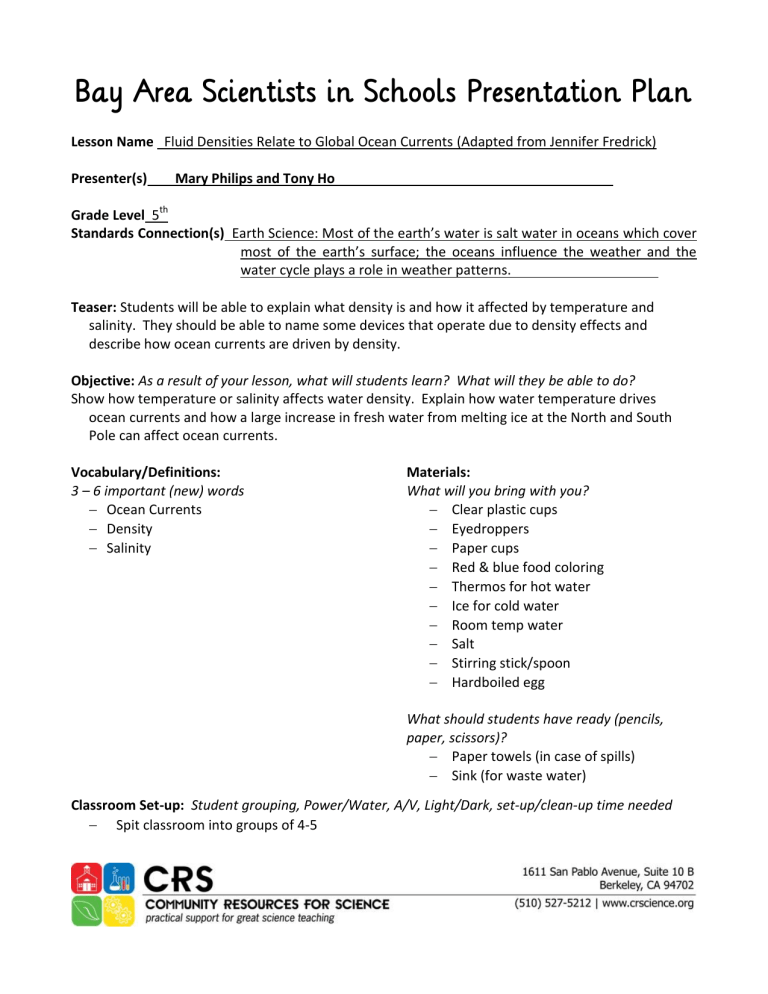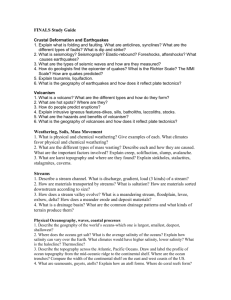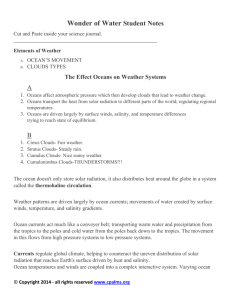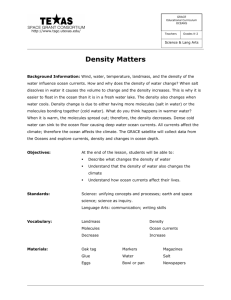adapted from SEED - Community Resources for Science

Bay Area Scientists in Schools Presentation Plan
Lesson Name Fluid Densities Relate to Global Ocean Currents (Adapted from Jennifer Fredrick)
Presenter(s) Mary Philips and Tony Ho
Grade Level 5 th
Standards Connection(s) Earth Science: Most of the earth’s water is salt water in oceans which cover most of the earth’s surface; the oceans influence the weather and the water cycle plays a role in weather patterns.
Teaser: Students will be able to explain what density is and how it affected by temperature and salinity. They should be able to name some devices that operate due to density effects and describe how ocean currents are driven by density.
Objective: As a result of your lesson, what will students learn? What will they be able to do?
Show how temperature or salinity affects water density. Explain how water temperature drives ocean currents and how a large increase in fresh water from melting ice at the North and South
Pole can affect ocean currents.
Vocabulary/Definitions:
3 – 6 important (new) words
Ocean Currents
Density
Salinity
Materials:
What will you bring with you?
Clear plastic cups
Eyedroppers
Paper cups
Red & blue food coloring
Thermos for hot water
Ice for cold water
Room temp water
Salt
Stirring stick/spoon
Hardboiled egg
What should students have ready (pencils, paper, scissors)?
Paper towels (in case of spills)
Sink (for waste water)
Classroom Set-up: Student grouping, Power/Water, A/V, Light/Dark, set-up/clean-up time needed
Spit classroom into groups of 4-5
Classroom Visit
1.
Personal Introduction: ____2_____ Minutes
Who are you? What do you want to share with students and why? How will you connect this with students’ interests and experiences? Introduce names, backgrounds, very brief description of what we work on.
Topic Introduction: What questions will you ask to learn from students? Big Idea(s), vocabulary, assessing prior knowledge…
“Today we will learn about density and salinity by conducting an experiment…
2.
Learning Experience(s):
What will you do, what will kids do? Demonstrations, hands-on activities, images, games, discussion, writing, measuring… Describe in order, including instructions to kids.
Experimental Setup
Spit classroom into groups of 4-5
Each group takes one clear plastic cup with cold blue water
Hand out one paper cup to each table filled with hot red water and eyedroppers. Tell students to be careful with the hot water!
2-3 min
Motivational Questions
Do you know what drives ocean currents?
Is the Bay filled with hot or cold water?
Do you think temperature influences ocean currents?
In the ocean, do you think the water is hotter at the top of the water surface or at the bottom of the ocean?
Let’s find out by doing an experiment!
Have the students make a hypothesis about if hot water is less dense than cold water.
Directions (Temp. Experiment)
Explain that the red food dye is for the hot water and the cold water is dyed blue.
Show the students how to inject the red hot water into the blue cold water, slowly letting the water fall down the side of the glass so as to reduce mixing.
Have the students write down what they observe and try to think of a reason why it agrees or disagrees with the hypothesis.
Temperature Experiment
The students follow directions and see that the cold water sinks and the hot water stays on top of the cold water. If the hot water is injected too quickly, it will cause mixing to occur. If the water sits out for too long, thermal equilibrium is reached and the fluid will mix itself.
2-3 min
5 min
10 min
If students have too much mixing and do not see the density results, give the students new hot and cold water so they can try again.
Review of Temperature Experiment
Ask the students what happened. Did everyone get the same results? If not, why? What was supposed to happen?
Did this prove or disprove the hypothesis?
Explain how the hot water is less dense than the cold water.
Ask the students if they can come up with other examples of density at work
(i.e. hot air balloons).
Motivational Questions (Salinity)
What is the difference between fresh and salt water?
Does the salt make the water denser or less dense?
Would you expect the bottom of the ocean to be more salty than the surface?
Do you think melting ice at the north or south poles affects the density of the ocean?
Have the students form a hypothesis of what will happen if we add salt water to fresh water.
10 min
5 min
Salinity Density Experiment
Give the students a cup of fresh water (uncolored) and salt water (colored green).
Have them use the eyedropper in the same manner as they did for the hot/cold experiment and drop the salt water into the fresh water.
Have the students write down what they observe and how it affects the hypothesis.
Review of Salinity Experiment
Was the hypothesis correct? Did everyone get the same results? Why or why not?
Explain how salty water is denser than fresh water and hot it affects ocean currents.
15 min
5 min
Floating Egg Demo
Have a glass cup with high salinity (dyed green) .
Show that a hardboiled egg floats on the water.
Have a glass cup with clear fresh water.
Show that a hardboiled egg sinks in the water.
Add fresh water to a half-full glass cup of salt water.
Ask the students what they think will happen based on density.
Show that the egg will float in the middle of the glass between the two layers.
Ask the students the relative density of the egg in comparison to salt water and fresh water.
10 min
Total 50 – 65 Minutes
Follow-up – After Presentation
Suggest students write a letter explaining “How we learned about fluid density and global ocean currents…”
Inverted Bottles ( Exploratorium ) - In this activity, learners investigate convection by using food coloring and water of different temperatures. Through this experiment, learners discover the effect of gravity, density, and temperature on fluids and the phenomenon that "hot things rise and cold things sink," which is an important part of the weather cycle, water currents, etc. http://www.exo.net/~emuller/activities/Inverted%20Bottles.pdf
Changing Density of a Liquid: Adding Solutes ( American Chemical Society Inquiry in Action - www.inquiryinaction.org
) Learners see that a carrot slice sinks in fresh water and floats in saltwater. Considering the placement of the carrot slice in water and saltwater, learners infer that the density of salt water must be greater than the density of fresh water. As a challenge, learners adjust the density of the saltwater until they get the carrot slice to hover somewhere in the middle of the cup. http://www.inquiryinaction.org/classroomactivities/activity.php?id=40
Rainbow Density Experiment ( Center of Science and Industry - www.cosi.org
) In this colorful activity
(page 6 of the PDF), learners will make a multicolor density column by using different concentrations of sugar solutions. They will see firsthand how differences in solution density cause layering. Although this activity was created as a pre-visit for a workshop about chemistry in cooking, it also makes an excellent stand-alone activity. http://smile.cosi.org/cooking-with-chemistryteacher-packet-and-classroom-activities.pdf#page=6
Reading Connections:
- Discover the Oceans: The World’s Largest Ecosystem by Lauri Berkenkamp and Chuck Forsman -
From both a historical and scientific point of view, above and below the surface, this engaging guide brings the world’s oceans to life through fun facts, illustrations, and in-depth information.
Interactive activities appear throughout, ranging from making solar stills and simple fishing spears to experimenting with a homemade diving bell and figuring out how much water it really takes to survive. With the oceans being the least explored environment on Earth, this reference illuminates some of the most incredible and surprising plants and animals as well as how to survive and navigate these vast expanses. http://www.amazon.com/Discover-Oceans-Worlds-Largest-
Ecosystem/dp/1934670383/








